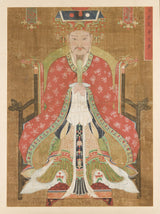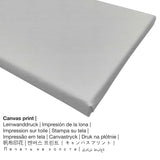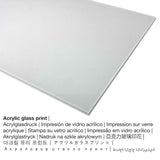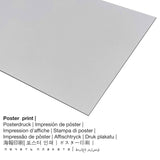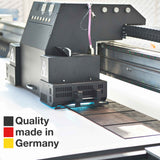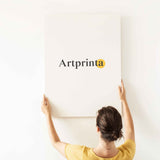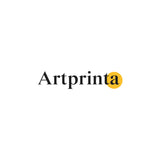Anonimo, 1700 - Ritratto dell'Imperatore Yan del Sud - stampa d'arte
Tasse incluse. Spedizione calcolata alla cassa.
Materiali del prodotto tra cui puoi scegliere
Per ogni stampa artistica offriamo diversi materiali e dimensioni. Scegli ora tra le seguenti opzioni di prodotto per soddisfare le tue preferenze in termini di dimensioni e materiale:
- Stampa dibond in alluminio: An Aluminium Dibond print is a print material with a true depth. The Aluminium Dibond Print is the best introduction to reproductions on alu. The white and bright sections of the work of art shimmer with a silk gloss, however without glare. Colors are vivid and luminous, the details of the print are very clear, and you can truly notice the matte appearance of the print.
- Poster stampato su materiale tela: The poster print is a printed flat cotton canvas paper with a nice structure on the surface. It is best used for framing the art print with a custom-made frame. Please keep in mind, that depending on the absolute size of the canvas poster print we add a white margin of something between 2-6cm round about the work of art in order to facilitate the framing with a custom frame.
- Tela: A canvas print, which shall not be mistaken with an artwork painted on a canvas, is a digital copy applied onto canvas fabric. How do I hang a canvas on my wall? Canvas prints are relatively low in weight. This means, it is quite simple to hang your Canvas print without the help of any wall-mounts. A canvas print is suited for all kinds of walls.
- Stampa su vetro acrilico: The acrylic glass print, often referenced as a UV print on plexiglass, will transform your favorite original artwork into magnificient home decoration. In addition, the acrylic glass fine art print is a viable alternative option to dibond and canvas art prints. The work of art is being printed with the help of state-of-the-art UV direct printing machines. It creates sharp and rich colors. The major benefit of an acrylic glass fine art copy is that contrasts plus artwork details will be recognizeable with the help of the very subtle tonal gradation.
Nota importante: We try our best to depict our art products in as much detail as possible and to display them visually in our shop. Still, the colors of the printing material and the print result may differ to a certain extent from the image on your device's screen. Depending on the screen settings and the nature of the surface, not all color pigments will be printed as exactly as the digital version. In view of the fact that all the fine art prints are printed and processed manually, there might as well be minor discrepancies in the motif's size and exact position.
Specifiche generali del museo (© Copyright - dal Los Angeles County Museum of Art - Los Angeles County Museum of Art)
The name of the subject of this painting, Nambang Yeomje (Chinese: Nanfang Yendi), appears in the inscription in the upper right corner. Facing the viewer and wearing a red robe, he sits on a chair decorated with dragon heads. He holds a scepter in his hands, and the sun and moon appear on his crown. Except for the fact that he is shown seated, he very much resembles portrayals of the attendants of Jeseokcheon (Sanskrit: Indra). Depictions of the Daoist personifications of the Big Dipper (Chilwon seonggun) also show them wearing hats that have sun-and-moon designs, and holding scepters. The LACMA panel is the only known painting of Nambang Yeomje with this iconography and with him shown as the sole subject matter of a single painting. Based on the inscription and the subject matter, this painting was probably one of an original set of five. Nambang Yeomje was Lord of the Southern Quadrant; the other four paintings would have shown the lords of the north, east, and west quadrants, in addition to a central figure. The five lords are differentiated only by the colors of their robes: their faces, positions, and clothing styles are the same. Intact examples of sets of these late Joseon dynasty (1800-1910) paintings exist in Gimryong Temple, South Gyeongsang province (fig. 1), and Tongdo Temple, South Gyeongsang province. The five-color scheme used in this painting is consistent with the important color scheme of Daoist theory, the Five Elements of the Cosmos, and yin and yang. Considering the five messengers’ names, the figures are very closely related to both times and the five directions. Nambang Yeomje can be found among the Daoist deities. According to the Chinese history Records of the Grand Historian (Shiji), Yeomje Shinong, successor to the throne of Fuxi (known as the founder of ancient China), was known as a lord of medicine and pioneer of agriculture. He studied herbs to make new medicines and he taught farmers how to make the land more productive. He was also given the name Yeomje (lord of fire) because he understood the inconvenience of the dark night and created lamps to be lit everywhere from oil-bearing trees. Then he created positions for and placed the five authorities that managed fire. The lords of the other directions also have counterparts in and represent other aspects of the Five Elements. The eastern lord rules over trees, the western lord rules over metals and heavenly punishments, and the northern lord rules the seas and winds. The center lord reigns over the world of ghosts and thunder; he also oversees the other lords. Originally, these figures were probably Daoist deities, and it is not clear when they entered the Buddhist cosmology. They might have been assimilated into Buddhism along with other Daoist deities such as mountain and kitchen gods, and the Buddhas of the Big Dipper (Chilseong Yeorae). It appears, however, that paintings of the five lords were not commonly enshrined in Buddhist temples, because there are many fewer paintings of them than of other Daoist deities. The pigments on the panel are painted somewhat thinly spread and the colors are harmoniously arranged. Nambang Yeomje’s dignity is expressed through his gentle facial expression and his refinement is apparent in the fine details of his robe (det.1, 2). The panel was probably painted in the early eighteenth century.
Descrizione
Questo capolavoro chiamato Portrait of Yan Emperor of the South è stato realizzato dal pittore Anonimo. The more than 320 year old original had the size 39 3/4 x 29 in (100,97 x 73,66 cm) and was produced with the techinque panel, ink and color on hemp or ramie. Questo pezzo d'arte appartiene alla Museo d'arte della contea di Los Angeles digital art collection, which is the largest art museum in the western United States, with a collection of more than 142.000 objects that illuminate 6.000 years of artistic expression across the globe. This artpiece, which is part of the dominio pubblico viene incluso con la cortesia di Museo d'arte della contea di Los Angeles (www.lacma.org)Il credito dell'opera d'arte è:. Inoltre, l'allineamento è ritratto con un rapporto laterale di 3: 4, il che significa che la lunghezza è del 25% più corta della larghezza.
Tavolo strutturato dell'opera d'arte
| Titolo del dipinto: | "Portrait of Yan Emperor of the South" |
| Classificazione dell'opera d'arte: | pittura |
| Termine generico: | arte classica |
| Secolo opera d'arte: | 18th secolo |
| Anno di creazione: | 1700 |
| Età delle opere d'arte: | intorno 320 anni |
| Mezzo di opera d'arte originale: | panel, ink and color on hemp or ramie |
| Dimensioni del materiale illustrativo originale: | 39 3/4 x 29 in (100,97 x 73,66 cm) |
| Museo: | Los Angeles County Museum of Art |
| Luogo del museo: | Los Angeles, California, Stati Uniti d'America |
| Sito del museo: | Los Angeles County Museum of Art |
| Tipo di licenza: | dominio pubblico |
| Per gentile concessione di: | Museo d'arte della contea di Los Angeles (www.lacma.org) |
Informazioni sul prodotto
| Stampa la categorizzazione: | stampa d'arte |
| Riproduzione: | riproduzione in formato digitale |
| Tecnica di fabbricazione: | Stampa diretta UV (stampa digitale) |
| Origine del prodotto: | Fabbricazione tedesca |
| Tipo di scorta: | su richiesta |
| Utilizzo proposto del prodotto: | decorazione murale, collezione d'arte (riproduzioni) |
| Allineamento dell'immagine: | allineamento verticale |
| Proporzioni dell'immagine: | 3: 4 - (lunghezza larghezza) |
| Implicazione delle proporzioni laterali: | la lunghezza è del 25% più corta della larghezza |
| Materiali disponibili per il prodotto: | stampa su metallo (dibond in alluminio), stampa su tela, stampa su vetro acrilico (con rivestimento in vero vetro), stampa su poster (carta su tela) |
| Opzioni dimensioni tela su telaio barella (stampa su tela): | 30 x 40 cm - 12 x 16 ", 60 x 80 cm - 24 x 31", 90 x 120 cm - 35 x 47 " |
| Stampa su vetro acrilico (con rivestimento in vero vetro): | 30 x 40 cm - 12 x 16 ", 60 x 80 cm - 24 x 31", 90 x 120 cm - 35 x 47 " |
| Opzioni formato stampa poster (carta tela): | 30 x 40 cm - 12 x 16 ", 60 x 80 cm - 24 x 31", 90 x 120 cm - 35 x 47 " |
| Opzioni di formato stampa dibond in alluminio (materiale in alluminio): | 30 x 40 cm - 12 x 16 ", 60 x 80 cm - 24 x 31", 90 x 120 cm - 35 x 47 " |
| Cornice stampa artistica: | nessuna cornice |
Informazioni generali sull'artista
| Artista: | Anonimo |
| Professioni dell'artista: | pittore |
| Categoria dell'artista: | vecchio maestro |
© Copyright di - Artprinta.com (Artprinta)

